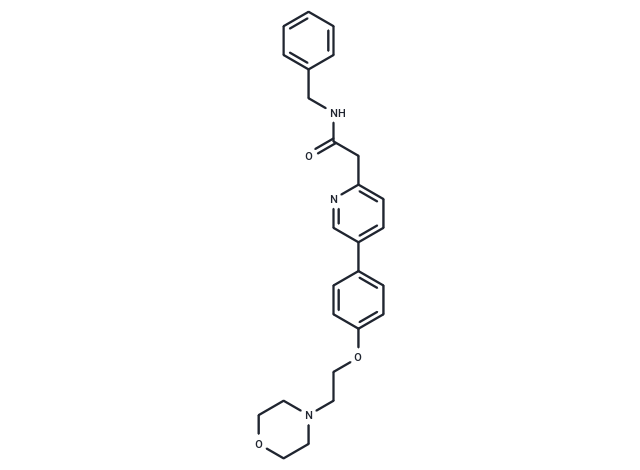Shopping Cart
- Remove All
 Your shopping cart is currently empty
Your shopping cart is currently empty

Tirbanibulin (KX2-391) is a highly selective Src kinase inhibitor that has demonstrated efficacy in pre-Clinicalal animal models of colon, pancreatic, prostate and breast cancer. It is a substrate-targeted kinase inhibitor. KX2-391, belongs to an emerging new family of targeted cancer treatments called protein kinase inhibitors.

| Pack Size | Price | Availability | Quantity |
|---|---|---|---|
| 1 mg | $30 | In Stock | |
| 5 mg | $61 | In Stock | |
| 10 mg | $74 | In Stock | |
| 25 mg | $162 | In Stock | |
| 50 mg | $295 | In Stock | |
| 100 mg | $495 | In Stock | |
| 500 mg | $1,090 | In Stock | |
| 1 mL x 10 mM (in DMSO) | $64 | In Stock |
| Description | Tirbanibulin (KX2-391) is a highly selective Src kinase inhibitor that has demonstrated efficacy in pre-Clinicalal animal models of colon, pancreatic, prostate and breast cancer. It is a substrate-targeted kinase inhibitor. KX2-391, belongs to an emerging new family of targeted cancer treatments called protein kinase inhibitors. |
| Targets&IC50 | Src (HuH-7):9 nM(GI50), Src (HepG2):60 nM(GI50), Src (Hep3B):26 nM(GI50), Src (PLC/PRF/5):13 nM(GI50) |
| In vitro | KX2-391, a Src inhibitor targeting the Src substrate pocket, demonstrates steep dose-response curves against Huh7 (GI50 = 9 nM), PLC/PRF/5 (GI50 = 13 nM), Hep3B (GI50 = 26 nM), and HepG2 (GI50 = 60 nM), four hepatic cell cancer (HCC) cell lines. It also inhibits leukemia cells resistant to current drugs, including those with the T3151 mutation. In engineered Src-driven cell growth assays with NIH3T3/c-Src527F and SYF/c-Src527F cells, KX2-391 shows GI50 values of 23 nM and 39 nM, respectively. [1][2] |
| In vivo | In pre-Clinicalal animal models of cancer, orally administered KX2-391 is shown to inhibit primary tumor growth and to suppress metastasis. [2] |
| Cell Research | Liver cell lines including Huh7, PLC/PRF/5, Hep3B, and HepG2 (NutriCyte, Buffalo, NY) are routinely cultured and maintained in basal medium containing 2% fetal bovine serum (FBS) at 37 °C and 5% CO2. Cells are seeded at 4.0 × 103/190 μL and 8.0 × 103/190 μL per well of 96-well plate in basal medium containing 1.5% FBS. These are cultured overnight at 37 °C and 5% CO2 prior to the addition of KX2-391, at concentrations ranging from 6,564 to 0.012 nM in triplicates. Treated cells are incubated for 3 days. Ten microliters of 3-(4,5-dimethylthiazol- 2-yl)-2,5-diphenyltetrazolium bromide (MTT) solution (5 mg/mL) is then added to each well on day 3 and cells incubated for 4 hours. The formazan product is dissolved with 10% SDS in dilute HCl. Optical density at 570 nm is measured by using BioTek Synergy HT multiplatform microplate reader. For comparison of activity and potency, parallel experiments are performed using KX2-391. Growth inhibition curves, 50% inhibition concentration (GI50), and 80% inhibition concentration (GI80) are determined using GraphPad Prism 5 statistical software. Data are normalized to represent percentage of maximum response as well as reported in optical density at wavelength of 570 nm (OD570) signal format.</ (Only for Reference) |
| Alias | KX2-391, KX-01 |
| Molecular Weight | 431.53 |
| Formula | C26H29N3O3 |
| Cas No. | 897016-82-9 |
| Smiles | O=C(Cc1ccc(cn1)-c1ccc(OCCN2CCOCC2)cc1)NCc1ccccc1 |
| Relative Density. | 1.169 g/cm3 |
| Storage | store at low temperature | Powder: -20°C for 3 years | In solvent: -80°C for 1 year | Shipping with blue ice. | |||||||||||||||||||||||||||||||||||
| Solubility Information | DMSO: 80 mg/mL (185.39 mM), Sonication is recommended. H2O: < 1 mg/mL (insoluble or slightly soluble) Ethanol: < 1 mg/mL (insoluble or slightly soluble) | |||||||||||||||||||||||||||||||||||
Solution Preparation Table | ||||||||||||||||||||||||||||||||||||
DMSO
| ||||||||||||||||||||||||||||||||||||

Copyright © 2015-2025 TargetMol Chemicals Inc. All Rights Reserved.